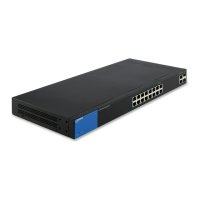199
•
T
FTP Server—Select whether to specify the TFTP server by IP address or domain
name.
•
IP Version—Select whether an IPv4 or an IPv6 address is used.
•
IPv6 Address Type
o
Link Local—The IPv6 address uniquely identifies hosts on a single network
link. A link local address has a prefix of FE80, is not routable, and can be
used for communication only on the local network. Only one link local
a
ddress is supported. If a link local address exists on the interface, thi
s
entry replaces the address in the configuration.
o
Global—The IPv6 address is a global Unicast IPV6 type that is visible and
reachable from other networks.
o
Interface—Select the link local interface (if IPv6 is used) from the list.
•
TFTP Server IP Address—Enter the IP address of the TFTP server.
•
TFTP Server Name—Enter the domain name of the TFTP server.
Note—If the server is selected by name in the Server Definition, there is no need to
select the IP version-related options.
4. Click Apply. The file is upgraded or backed up.
5. If you selected via HTTP/HTTPS, enter the parameters as described in this step.
•
Command—Select one of the following options:
o
Download— Transfer the source file of the local device to the destination
file on this switch.
o
Backup— Transfer the source file to the local device.
•
Source File Name—Enter the file name for download.
•
Destination File—Select the configuration file type to be downloaded to.
Only valid file types are displayed. (The file types are described in the Files and File
T
ypes section).
6. Click Apply. The file is upgraded or backed up.
Note—When the process initiated is completed, the following information is displayed:
•
Bytes Transferred—How many bites were transferred in the process.
•
Status—Did the process succeed or fail.
•
Error Message—Reason for failure of the process.

